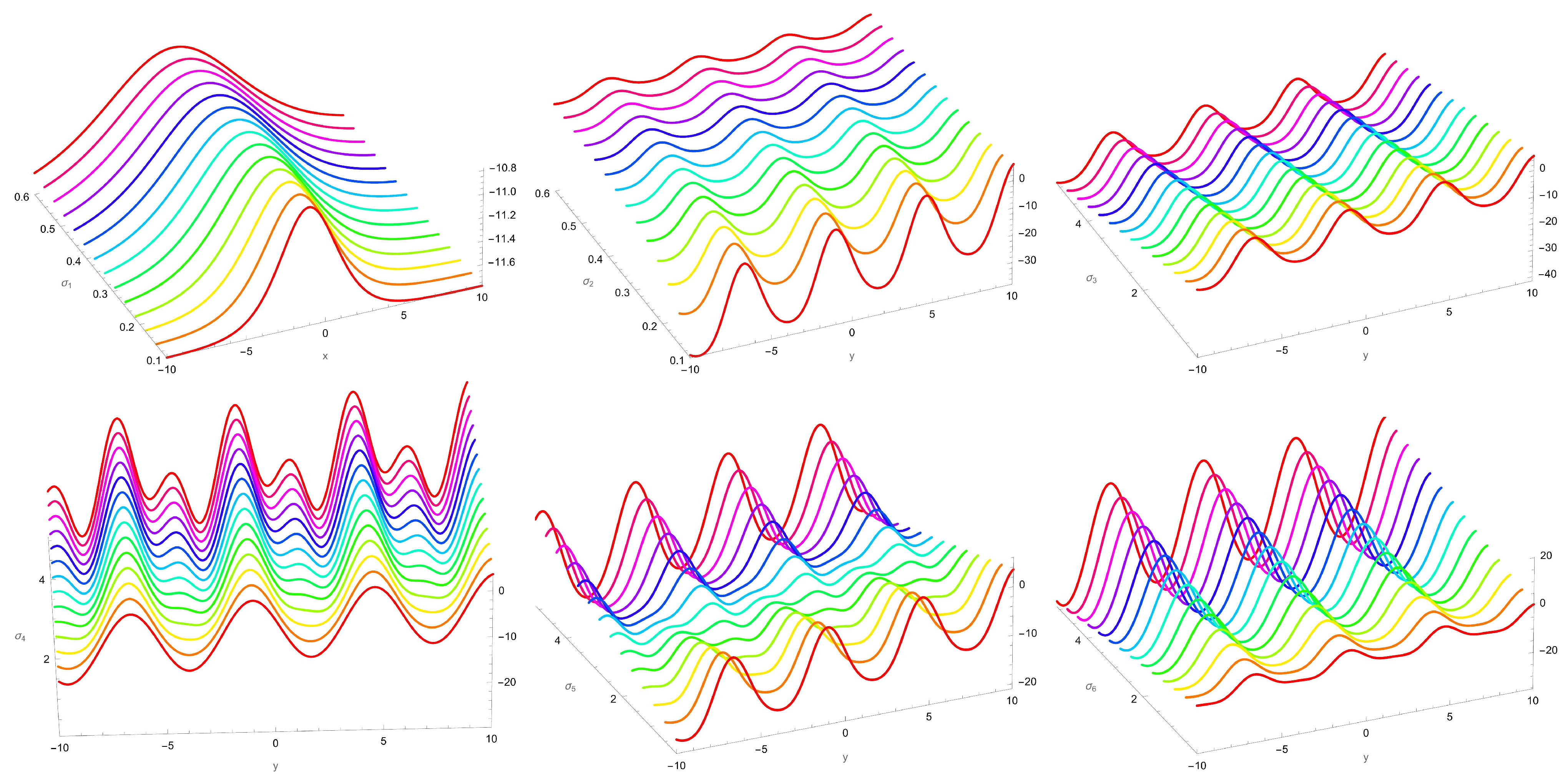On Exact Non-Traveling Wave Solutions to the Generalized Nonlinear Kadomtsev–Petviashvili Equation in Plasma Physics and Fluid Mechanics
Abstract
1. Introduction
2. The First Reduction Procedure for Equation (1)
2.1. The Soliton Solutions for Equation (9)
- Set 1: Letting and in Equation (20) gives
- Case 1-1: In this case, the rest of the parameters can be attained aswhere and are free-chosen parameters.
- Case 1-2: In this case, the rest of the parameters can be attained aswhere and are free-chosen parameters.
- Case 4-2: In this case, the remaining parameters can be obtained as follows:where and are free-chosen parameters.
- Set 5: Letting and in Equation (20) gives
- Case 5-1: In this case, the rest of the parameters can be attained aswhere and are free-chosen parameters.
- Case 7: In this case, the unknown parameters are obtained aswhere , and are free-chosen parameters.
- Case 8: In this case, the unknown parameters are obtained aswhere , and are free-chosen parameters.
2.2. The Extraction of Soliton Solutions to (18) Using a Logarithm Transformation
3. The Second Reduction Procedure for Equation (1)
4. Conclusions
Funding
Data Availability Statement
Acknowledgments
Conflicts of Interest
References
- Mandal, M.; Das, A.; Ma, W.X. Integrability, breather, rogue wave, lump, lump-multi-stripe, and lump-multisoliton solutions of a (3+1)-dimensional nonlinear evolution equation. Phys. Fluids 2024, 36, 037151. [Google Scholar] [CrossRef]
- Bertola, M.; Jenkins, R.; Tovbis, A. Partial degeneration of finite gap solutions to the Korteweg–de Vries equation: Soliton gas and scattering on elliptic backgrounds. Nonlinearity 2023, 36, 3622. [Google Scholar] [CrossRef]
- Gao, X.Y. In plasma physics and fluid dynamics: Symbolic computation on a (2+1)-dimensional variable-coefficient Sawada-Kotera system. Appl. Math. Lett. 2025, 159, 109262. [Google Scholar] [CrossRef]
- Yang, J.J.; Tian, S.F.; Li, Z.Q. Inverse scattering problem for the matrix modified Korteweg–de Vries equation with finite density type initial data. Physica D 2023, 455, 133911. [Google Scholar] [CrossRef]
- Wazwaz, A.M. Partial Differential Equations and Solitary Waves Theorem; Springer: Berlin/Heidelberg, Germany, 2009. [Google Scholar]
- Liu, Y.; Gao, Y.T.; Sun, Z.Y.; Yu, X. Multi-soliton solutions of the forced variable-coefficient extended Korteweg–de Vries equation arisen in fluid dynamics of internal solitary waves. Nonlinear Dyn. 2011, 66, 575. [Google Scholar] [CrossRef]
- Zhao, J.X.; Guo, B.L. Analytic solutions to forced KdV equation. Commun. Theor. Phys. 2009, 52, 279. [Google Scholar]
- Freeman, N.C.; Nimmo, J.J.C. Soliton solutions of the Korteweg-de Vries and the Kadomtsev–Petviashvili equations: The Wronskian technique. Phys. Lett. A 1983, 95, 1–3. [Google Scholar] [CrossRef]
- Hietarinta, J.; Joshi, N.; Nijhoff, F.W. Discrete Systems and Integrability; Cambridge Texts in Applied Mathematics; Cambridge University Press: Cambridge, UK, 2016. [Google Scholar]
- Nijhoff, F.W.; Jennings, P. On an elliptic extension of the Kadomtsev-Petviashvili equation. J. Phys. A Math. Theor. 2014, 47. [Google Scholar]
- Guo, B.; Ling, L.; Liu, Q.P. Nonlinear Schrödinger equation: Generalized Darboux transformation and rogue wave solutions. Phys. Rev. E 2012, 85, 026607. [Google Scholar] [CrossRef]
- Foroutan, M.; Manafian, J.; Ranjbaran, A. Lump solution and its interaction to (3+1)-D potential-YTSF equation. Nonlinear Dyn. 2018, 92, 2077–2092. [Google Scholar] [CrossRef]
- Wazwaz, A.M. Multiple-soliton solutions for the KP equation by Hirota’s bilinear method and by the tanh-coth method. Appl. Math. Comput. 2007, 190, 633–640. [Google Scholar] [CrossRef]
- Tian, S.F.; Ma, P.L. On the quasi-periodic wave solutions and asymptotic analysis to a (3+1)-dimensional generalized Kadomtsev–Petviashvili equation. Commun. Theor. Phys. 2014, 62, 245–258. [Google Scholar] [CrossRef]
- Hu, C.C.; Tian, B.; Yin, H.M.; Zhang, C.R.; Zhang, Z. Dark breather waves, dark lump waves and lump wave-soliton interactions for a (3+1)-dimensional generalized Kadomtsev–Petviashvili equation in a fluid. Comput. Math. Appl. 2019, 78, 166–177. [Google Scholar] [CrossRef]
- Wang, M.; Tian, B.; Sun, Y.; Yin, H.M.; Zhang, Z. Mixed lump-stripe, bright rogue wave-stripe, dark rogue wave-stripe and dark rogue wave solutions of a generalized Kadomtsev–Petviashvili equation in fluid mechanics. Chin. J. Phys. 2019, 60, 440–449. [Google Scholar] [CrossRef]
- Yu, W.; Zhang, H.; Zhou, Q.; Biswas, A.; Alzahrani, A.K.; Liu, W. The mixed interaction of localized, breather, exploding and solitary wave for the (3+1)-dimensional Kadomtsev–Petviashvili equation in fluid dynamics. Nonlinear Dyn. 2020, 100, 1611–1619. [Google Scholar] [CrossRef]
- Alsallami, S.A.M. Discrete Integrable Systems and Geometric Numerical Integration. Ph.D. Thesis, University of Leeds, Leeds, UK, 2018. [Google Scholar]
- Alsallami, S.A.M.; Niesen, J.; Nijhoff, F.W. Closed-form modified Hamiltonians for integrable numerical integration schemes. Nonlinearity 2018, 31, 5110. [Google Scholar] [CrossRef]
- Novikov, S.P. The periodic problem for the Korteweg-de Vries equation. Funct. Anal. Appl. 1974, 8, 54–66. [Google Scholar]
- Ma, W.X. Lump solutions to the Kadomtsev–Petviashvili equation. Phys. Lett. A 2015, 379, 1975–1978. [Google Scholar] [CrossRef]
- Ma, W.X.; Zhou, Y. Lump solutions to nonlinear partial differential equations via Hirota bilinear forms. J. Differ. Equ. 2018, 264, 2633–2659. [Google Scholar] [CrossRef]
- Ma, W.X. Comment on the (3+1) dimensional Kadomtsev–Petviashvili equations. Commun. Nonlinear Sci. Numer. Simul. 2011, 16, 2663–2666. [Google Scholar] [CrossRef]
- Ying, L.; Li, M.; Shi, Y. New exact solutions and related dynamic behaviors of a (3+1)-dimensional generalized Kadomtsev–Petviashvili equation. Nonlinear Dyn. 2024, 112, 11349–11372. [Google Scholar] [CrossRef]
- Liu, J.-G.; Tian, Y.; Hu, J.-G. New non-traveling wave solutions for the (3+1)-dimensional Boiti–Leon–Manna–Pempinelli equation. Appl. Math. Lett. 2018, 79, 162–168. [Google Scholar] [CrossRef]
- Lv, L.; Shang, Y. Abundant new non-travelling wave solutions for the (3+1)-dimensional potential YTSF equation. Appl. Math. Lett. 2020, 107, 106456. [Google Scholar] [CrossRef]
- Shang, Y. Abundant explicit non-traveling wave solutions for the (2+1)-dimensional breaking soliton equation. Appl. Math. Lett. 2022, 131, 108029. [Google Scholar] [CrossRef]
- Xu, Y.; Zheng, X.; Xin, J. New non-traveling wave solutions for the (2+1)-dimensional variable coefficients Date-Jimbo-Kashiwara-Miwa equation. Chaos Solit. Fractals 2022, 155, 111661. [Google Scholar] [CrossRef]
- Zheng, X.; Zhao, L.; Xu, Y. A new composite technique to obtain non-traveling wave solutions of the (2+1)-dimensional extended variable coefficients Bogoyavlenskii–Kadomtsev–Petviashvili equation. Qual. Theory Dyn. Syst. 2023, 22, 83. [Google Scholar] [CrossRef]
- Ghanbari, B. New analytical solutions for the Oskolkov-type equations in fluid dynamics via a modified methodology. Results Phys. 2021, 28, 104610. [Google Scholar] [CrossRef]
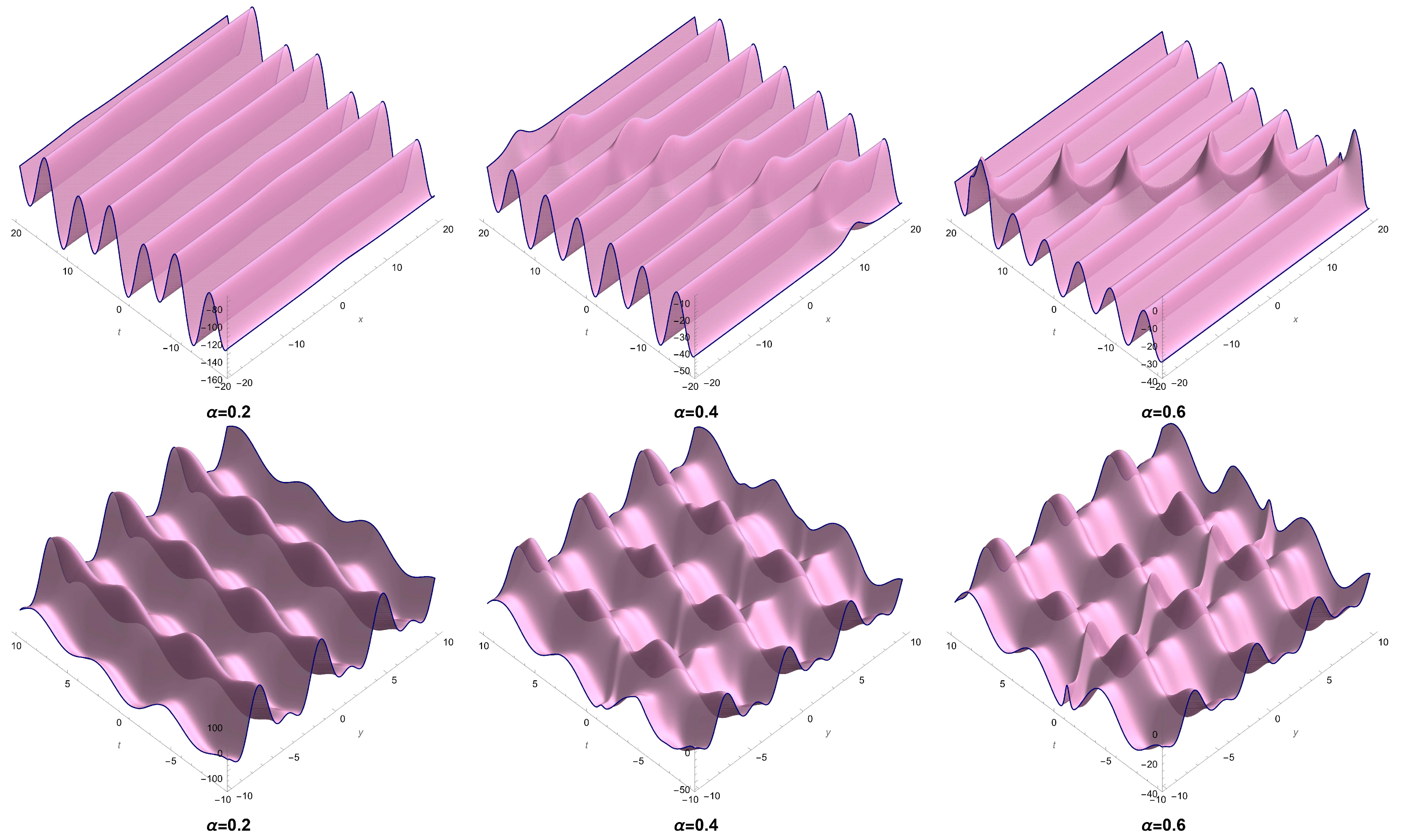


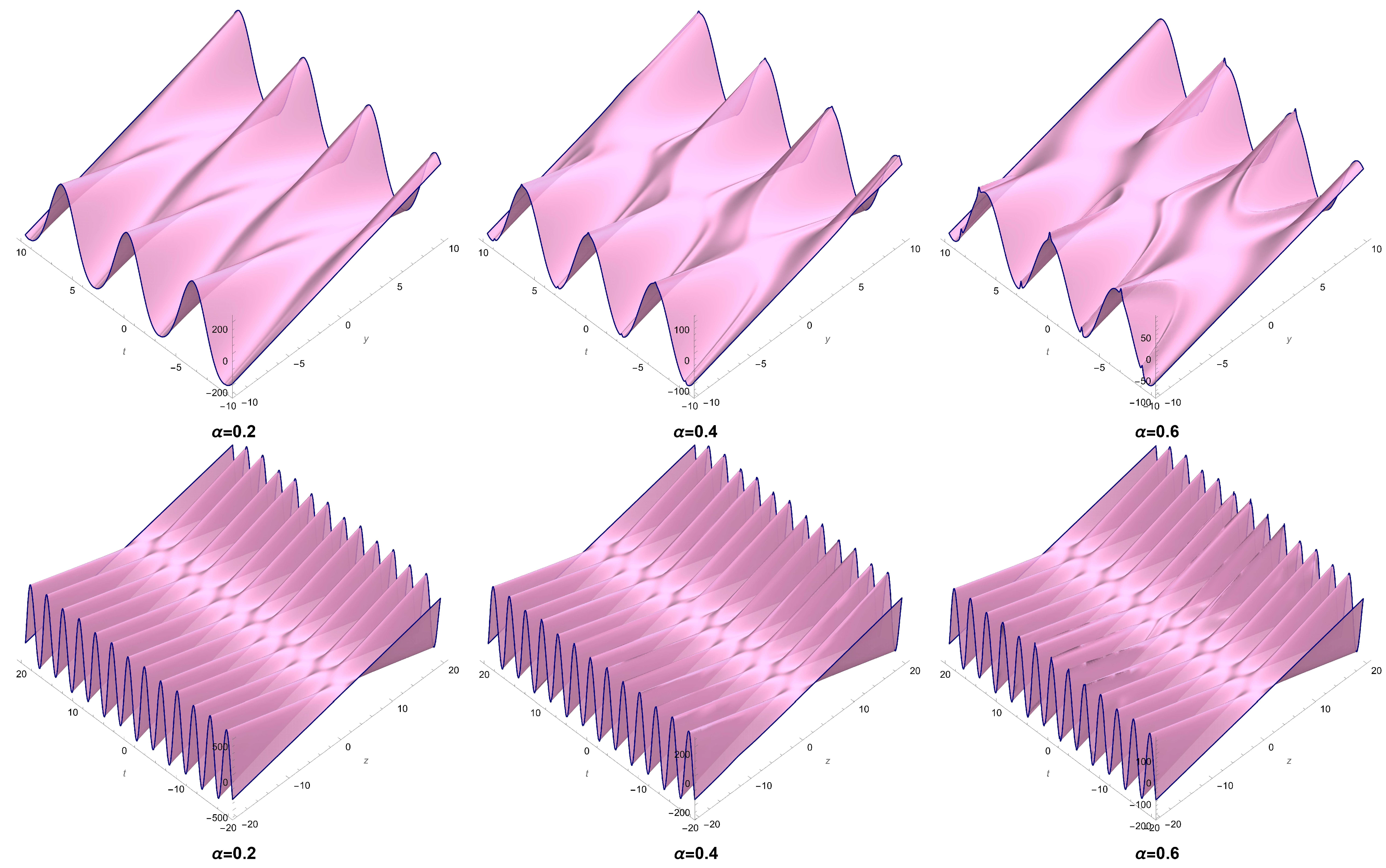
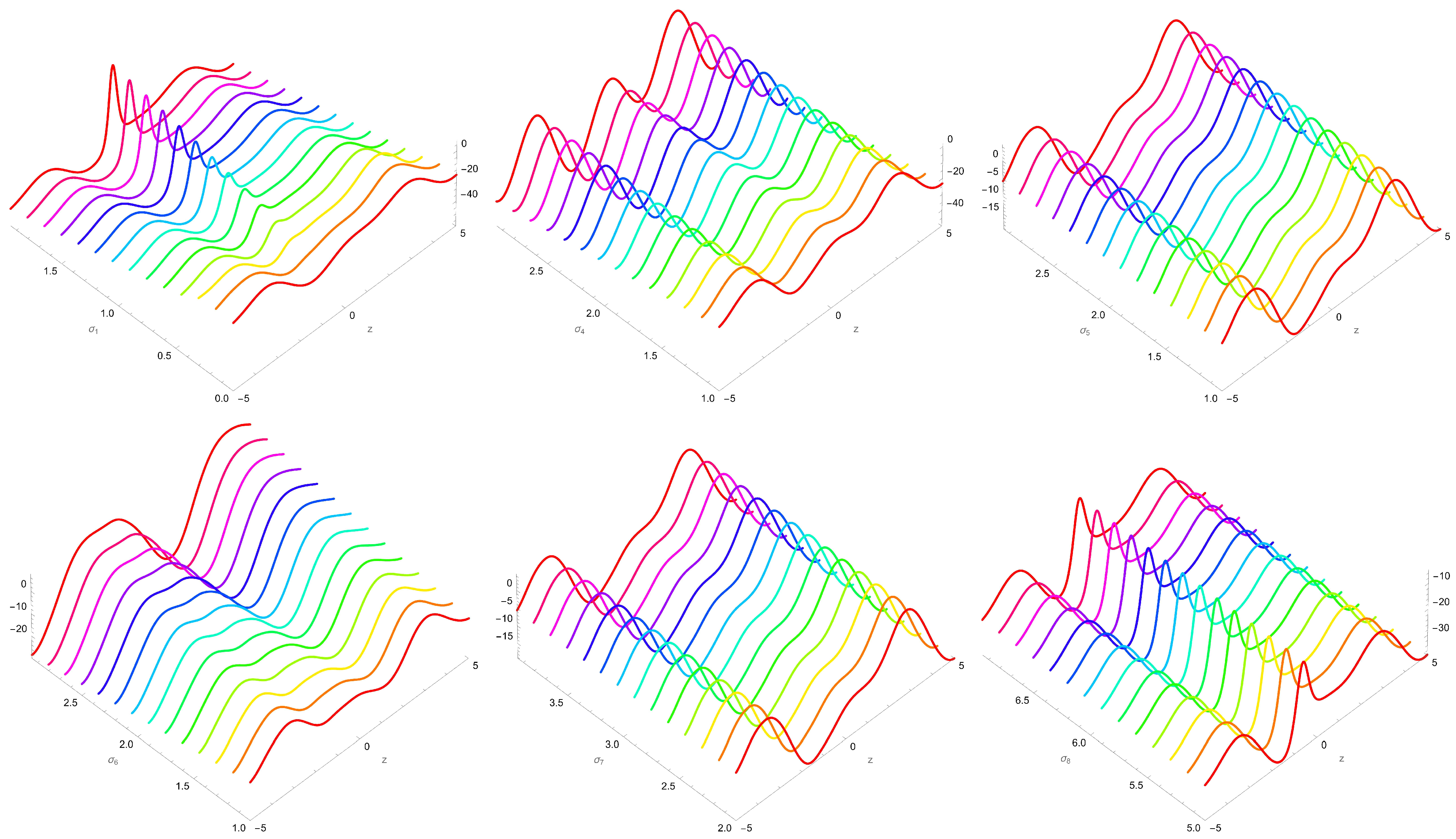

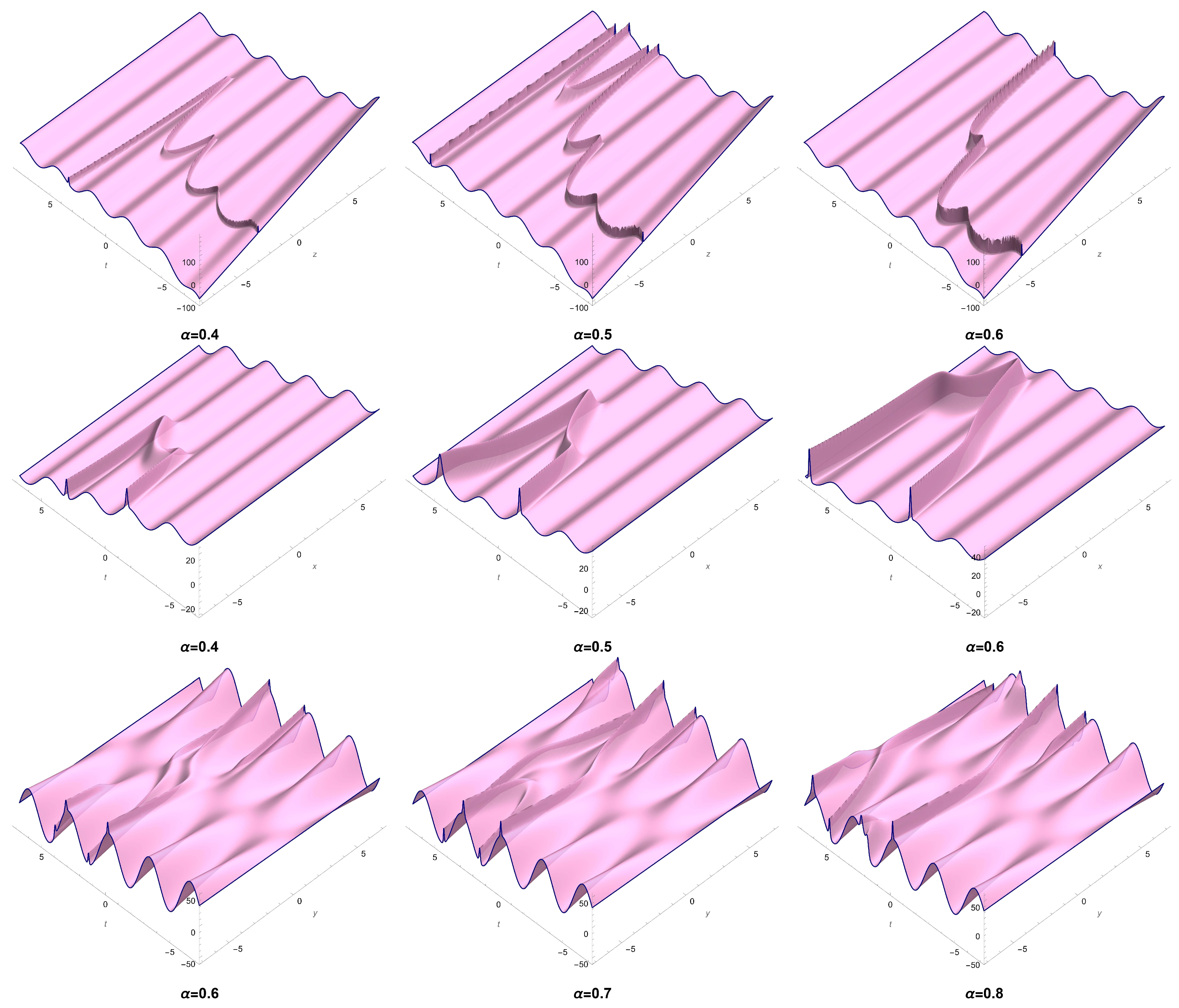
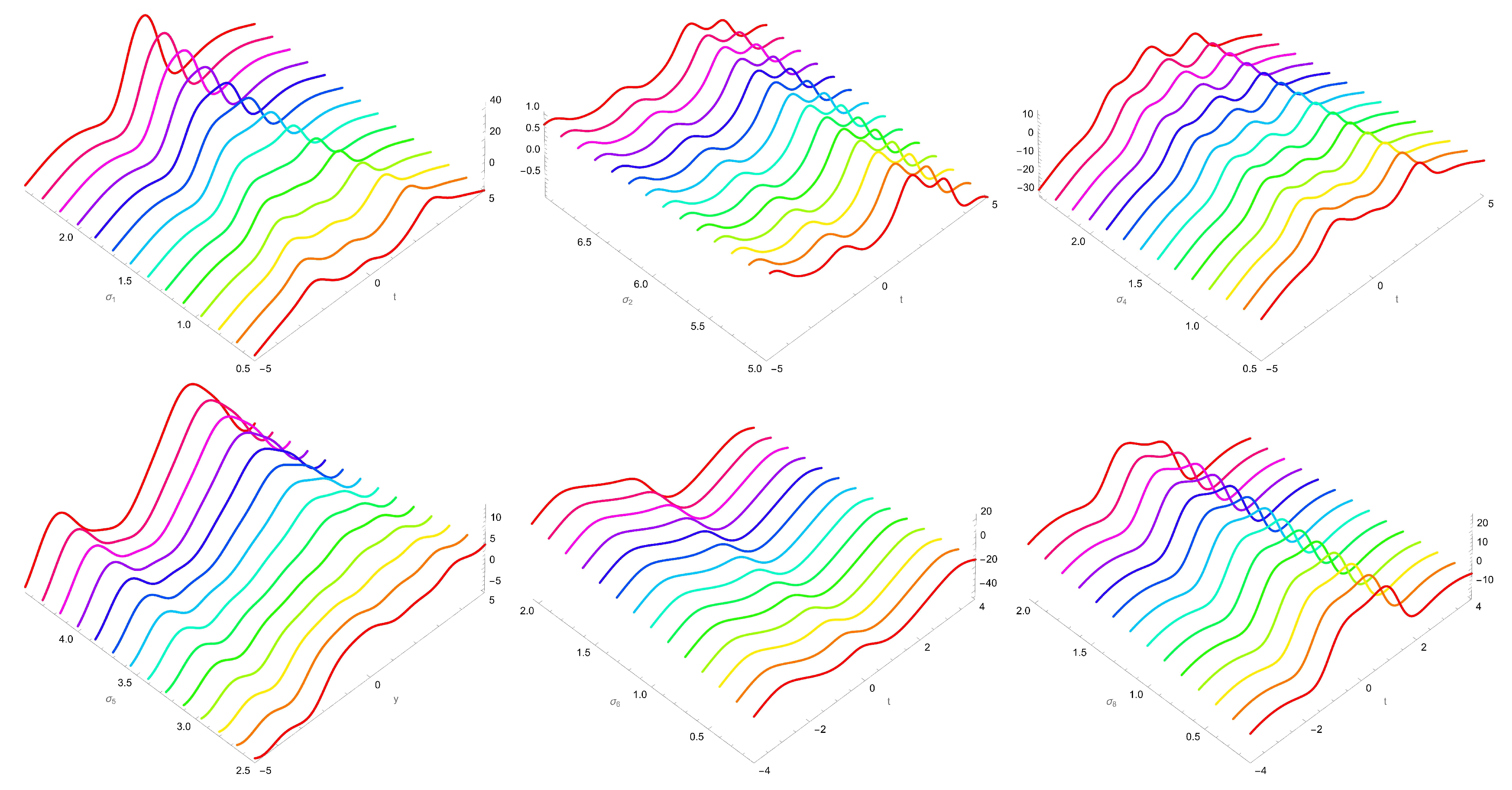
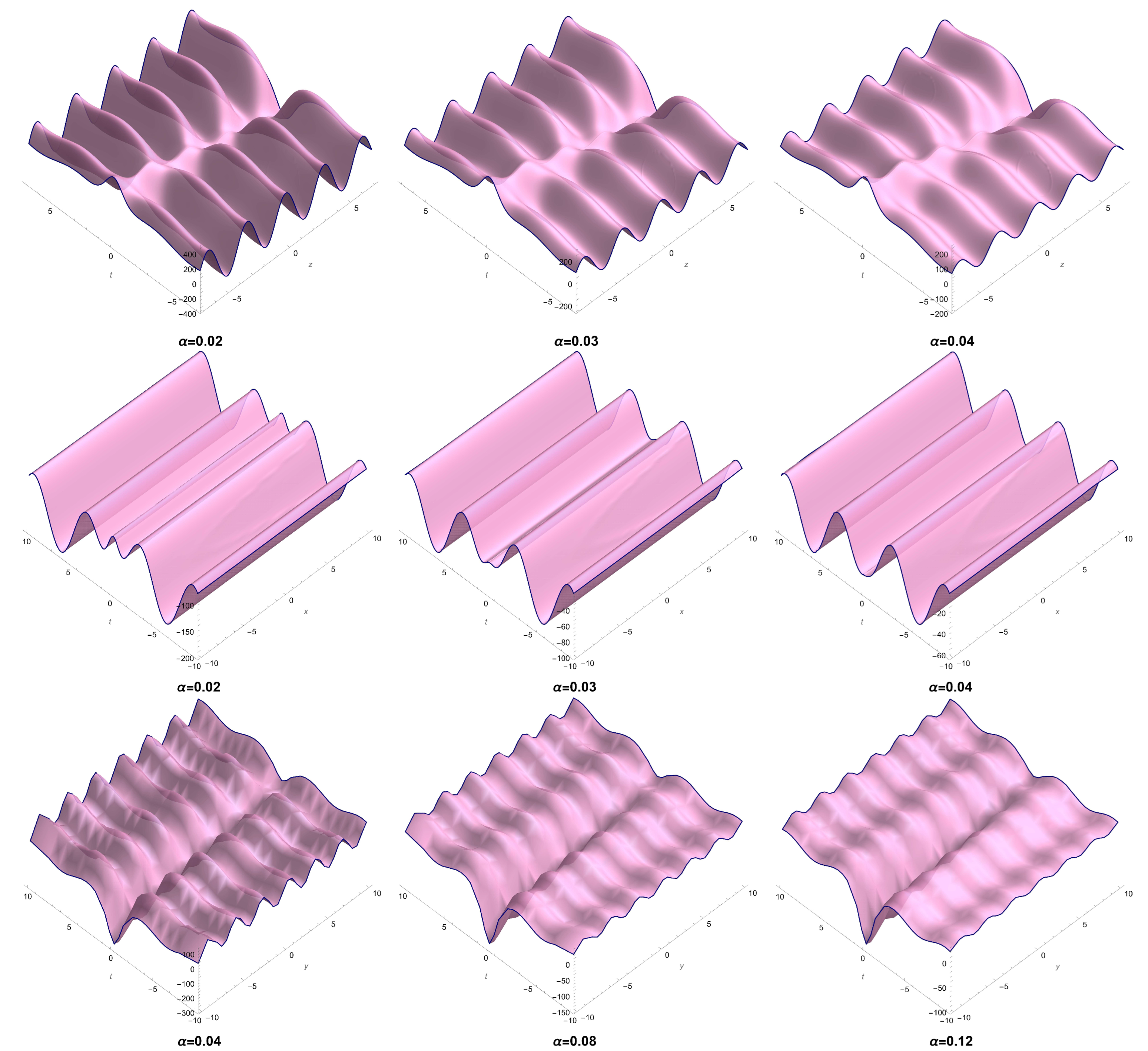
Disclaimer/Publisher’s Note: The statements, opinions and data contained in all publications are solely those of the individual author(s) and contributor(s) and not of MDPI and/or the editor(s). MDPI and/or the editor(s) disclaim responsibility for any injury to people or property resulting from any ideas, methods, instructions or products referred to in the content. |
© 2025 by the author. Licensee MDPI, Basel, Switzerland. This article is an open access article distributed under the terms and conditions of the Creative Commons Attribution (CC BY) license (https://creativecommons.org/licenses/by/4.0/).
Share and Cite
Alsallami, S.A.M. On Exact Non-Traveling Wave Solutions to the Generalized Nonlinear Kadomtsev–Petviashvili Equation in Plasma Physics and Fluid Mechanics. Mathematics 2025, 13, 1914. https://doi.org/10.3390/math13121914
Alsallami SAM. On Exact Non-Traveling Wave Solutions to the Generalized Nonlinear Kadomtsev–Petviashvili Equation in Plasma Physics and Fluid Mechanics. Mathematics. 2025; 13(12):1914. https://doi.org/10.3390/math13121914
Chicago/Turabian StyleAlsallami, Shami A. M. 2025. "On Exact Non-Traveling Wave Solutions to the Generalized Nonlinear Kadomtsev–Petviashvili Equation in Plasma Physics and Fluid Mechanics" Mathematics 13, no. 12: 1914. https://doi.org/10.3390/math13121914
APA StyleAlsallami, S. A. M. (2025). On Exact Non-Traveling Wave Solutions to the Generalized Nonlinear Kadomtsev–Petviashvili Equation in Plasma Physics and Fluid Mechanics. Mathematics, 13(12), 1914. https://doi.org/10.3390/math13121914





